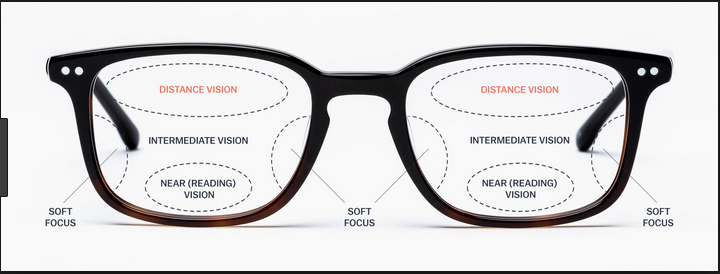Varifocal Problems
I personally enjoy wearing varifocal lenses, I recommend them every day, and I am excited to talk about them every day as an Optician. I personally love them, I wear them every single day. However, there are a few common problems that you need to be aware of. When clients cannot use varifocals, they can often feel guilty, but it is not their fault or the optician’s fault. It is simply the way it is. Your brain’s ability to deal with the different parts of the lens is what determines a great deal of these issues.
Some varifocal problems are caused by misalignment of the lenses in the frame and can sometimes be remedied by refitting the frame.
You can wear varifocals successfully if you are aware that they have limitations and that some people may experience difficulties. Having all the information prepares you to deal with any issues that may arise. Forewarned is forearmed as they say! In spite of the fact that many people will experience no problems with varifocals, it is important to be aware that they can occur.
-
One of the largest problems is swimming and sway, which is caused by distortion at the edge of the lenses. When you move your head, you may feel the sides of your vision moving. This can cause some people to become nauseous. When you step forward on a treadmill and then step off, it is common for you to feel the room moving forwards and backwards in the periphery of your vision as you step forward – this is a similar experience for clients who are wearing varifocals. There is no need to worry, it will get better. I know from years of experience (unfortunately over 20 years!) that if you put them on and leave them on for two weeks, your brain will begin to adapt to them. This can take up to two weeks. It is not possible to put them on for two weeks for an hour or two each day. This is a big ask, but it is effective.
-
We will need to carefully examine what is going on if you cannot find the reading vision. This can sometimes be an odd situation. Although the power for reading vision is in there, you simply are not able to read very well. Is it a problem with your head position? As a first-time user, you may often drop your chin rather than your eyes to read. In most cases, you end up getting into the wrong position if you think about it too much in order to determine the correct lens power. Once you stop thinking about what you ought to be doing, it is possible to naturally drop your eyes. Is your reading part too low down on the lens? It is possible that the power you require is too far down, making it necessary for you to raise the glasses to be able to see. We can redesign the varifocal to shorten this change (referred to as the corridor), allowing the reading portion to be located closer to the lens.
I wish to make sure all varifocal wearers are prepared for any situations that may arise when wearing varifocals, as there are a few things that can cause problems. Increasing prescription strength may lead to increased distortion in lenses even for experienced wearers.
You should consult your Optician and their team as soon as possible if you experience any of these problems. Although some problems are more difficult than others, for example, the brain may need time to adapt to changes. Generally, it is worthwhile to continue wearing varifocals as they have many benefits that are greater than having to switch glasses from one type to another. Unfortunately, some people’s brains will not be able to accept the changes. There is a phenomenon known as a non-tolerance to varifocals. It is most commonly caused by the swim and sway of the lens or the inability to locate reading vision, even though the lens checks out properly. You would never be stuck with glasses you cannot use if our varifocals are guaranteed and can be swapped for another lens solution.
















